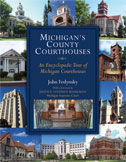By ERIC FREEDMAN
Capital News Service
LANSING – They’re landmarks, community anchors, subjects of controversy and venues for drama and confrontation.
They’re also components of the humdrum day-to-day business of government — often expensive to operate and sometimes lagging far behind the technological demands of the 21st century justice system.
They’re the county courthouses usually found in the center of town, with statues of long-dead local figures and cannon from old wars scattered around the lawn and cramped holding cells inside.
“Courthouses are symbols. Physically they stand, but figuratively they speak,” writes John Fedynsky, a Lansing-based assistant attorney general and the author of what he calls an “encyclopedic tour” of the state’s diverse circuit courthouses.
To research the book, Fedynsky traveled to all 83 county seats and noted, among other things, that many are on streets named “Main, State, Division, Huron, Ottawa or Saginaw.”
They range from Michigan’s oldest operating courthouse — an 1846 Greek Revival structure in Lapeer County — to its newest, Ottawa County’s 2009 building in Grand Haven. Alpena County uses a Depression-era art deco building, while utilitarian-looking structures suffice in Harrison, Clare County, and Petoskey, Emmet County.
It’s impossible to separate the buildings from the people who use them, and “the human element of the inanimate objects cannot be denied,” he writes in “Michigan’s County Courthouses” (University of Michigan Press, $40).
For example, he relates the tale of a jilted man who fatally shot his lover in Mason County in 1939. “In the span of 48 hours he committed the crime, surrendered immediately, was charged, convicted and sent on his way to serve a life sentence.”
And the 1888 Gogebic County Courthouse in Bessemer hosted a murder trial stemming from the last known stagecoach robbery east of the Mississippi River, according to Fedynsky. The defendant, “a German immigrant who spoke broken English but was fluent in the universal language of violence,” received a life sentence.
The Marquette County Courthouse has a different tie to history – movie history. Jimmy Stewart, Lee Remick, George C. Scott and Ben Gazzara were there for the 1959 filming of “Anatomy of a Murder.” The movie was based on the best-selling novel by a state Supreme Court justice from the Upper Peninsula, John Voelker.
Given their historic significance, it’s unsurprising that some have been intensively and expensively restored to avert obsolescence, abandonment and even demolition. That was true of the Grand Traverse County Courthouse in Traverse City and the St. Joseph County Courthouse in Centreville, both dating to 1900.
Even retired courthouses can be community assets. For instance, in 2002 a new court and jail complex in Stanton replaced the 1910 Montcalm County Courthouse, but the 90-year-old structure still houses county offices.
© 2010, Capital News Service, Michigan State University School of Journalism. Not to be reproduced without permission.
Spartan Newsroom - News and information from student journalists at the Michigan State University School of Journalism
Spartan Newsroom (https://news.jrn.msu.edu/2010/12/county-courthouses-showcase-reflect-michigans-legacy/)